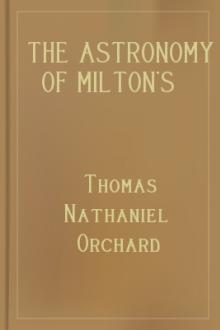The Astronomy of Milton's 'Paradise Lost' by Thomas Nathaniel Orchard (easy books to read in english TXT) 📕

- Author: Thomas Nathaniel Orchard
- Performer: -
Book online «The Astronomy of Milton's 'Paradise Lost' by Thomas Nathaniel Orchard (easy books to read in english TXT) 📕». Author Thomas Nathaniel Orchard
We now reach the name of Hipparchus of Bithynia (140 B.C.), the most illustrious astronomer of antiquity, who did much to raise astronomy to the position of a true science, and who has also left behind him ample evidence of his genius ‘as a mathematician, an observer, and a theorist.’ We are indebted to him for the earliest star catalogue, in which he included 1,081 stars. He discovered the Precession of the Equinoxes, and determined the motions of the Sun and Moon, and also the length of the year, with greater precision than any of his predecessors. He invented the sciences of plane and spherical trigonometry, and was the first to use right ascensions and declinations.
The next astronomer of eminence after Hipparchus was Ptolemy (130 A.D.), who resided at Alexandria. He was skilled as a mathematician and geographer, and also excelled as a musician. His chief discovery was an irregularity of the lunar motion, called the ‘evection.’ He was also the first to observe the effect of the refraction of light in causing the apparent displacement of a heavenly body from its true position. Ptolemy devoted much of his time to extending and improving the theories of Hipparchus, and compiled a great treatise, called the ‘Almagest,’ which contains nearly all the knowledge we possess of ancient astronomy. Ptolemy’s name is, however, most widely known in association with what is called the Ptolemaic theory. This system, which originated long before his time, but of which he was one of the ablest expounders, was an attempt to establish on a scientific basis the conclusions and results arrived at by early astronomers who studied and observed the motions of the heavenly bodies. Ptolemy regarded the Earth as the immovable centre of the universe, round which the Sun, Moon, planets, and the entire heavens completed a daily revolution in twenty-four hours. After the death of Ptolemy no worthy successor was found to occupy his place, the study of astronomy began to decline among the Greeks, and after a time it ceased to be cultivated by that people.
The Arabs next took up the study of astronomy, which they prosecuted most assiduously for a period of four centuries. Their labours were, however, confined chiefly to observational work, in which they excelled; unlike their predecessors, they paid but little attention to speculative theories—indeed, they regarded with such veneration the opinions held by the Greeks, that they did not feel disposed to question the accuracy of their doctrines. The most eminent astronomer among the Arabs was Albategnius (680 A.D.). He corrected the Greek observations, and made several discoveries which testified to his abilities as an observer. Ibn Yunis and Abul Wefu were Arab astronomers who earned a high reputation on account of the number and accuracy of their observations. In Persia, a descendant of the famous Genghis Khan erected an observatory, where astronomical observations were systematically made. Omar, a Persian astronomer, suggested a reformation of the calendar which, if it had been adopted, would have insured greater accuracy than can be attained by the Gregorian style now in use. In 1433, Ulugh Beg, who resided at Samarcand, made many observations, and constructed a star catalogue of greater exactness than was known to exist prior to his time. The Arabs may be regarded as having been the custodians of astronomy until the time of its revival in another quarter of the Globe.
After the lapse of many centuries, astronomy was introduced into Western Europe in 1220, and from that date to the present time its career has been one of triumphant progress. In 1230, a translation of Ptolemy’s ‘Almagest’ from Arabic into Latin was accomplished by order of the German Emperor, Frederick II.; and in 1252 Alphonso X., King of Castile, himself a zealous patron of astronomy, caused a new set of astronomical tables to be constructed at his own expense, which, in honour of his Majesty, were called the ‘Alphonsine Tables.’ Purbach and Regiomontanus, two German astronomers of distinguished reputation, and Waltherus, a man of considerable renown, made many important observations in the fifteenth century.
The most eminent astronomer who lived during the latter part of this century was Copernicus. Nicolas Copernicus was born February 19, 1473, at Thorn, a small town situated on the Vistula, which formed the boundary between the kingdoms of Prussia and Poland. His father was a Polish subject, and his mother of German extraction. Having lost his parents early in life, he was educated under the supervision of his uncle Lucas, Bishop of Ermland. Copernicus attended a school at Thorn, and afterwards entered the University of Cracow, in 1491, where he devoted four years to the study of mathematics and science. On leaving Cracow he attached himself to the University of Bologna as a student of canon law, and attended a course of lectures on astronomy given by Novarra. In the ensuing year he was appointed canon of Frauenburg, the cathedral city of the Diocese of Ermland, situated on the shores of the Frisches Haff. In the year 1500 he was at Rome, where he lectured on mathematics and astronomy. He next spent a few years at the University of Padua, where, besides applying himself to mathematics and astronomy, he studied medicine and obtained a degree. In 1505 Copernicus returned to his native country, and was appointed medical attendant to his uncle, the Bishop of Ermland, with whom he resided in the stately castle of Heilsberg, situated at a distance of forty-six miles from Frauenburg. Copernicus lived with his uncle from 1507 till 1512, and during that time prosecuted his astronomical studies, and undertook, besides, many arduous duties associated with the administration of the diocese; these he faithfully discharged until the death of the Bishop, which occurred in 1512. After the death of his uncle he took up his residence at Frauenburg, where he occupied his time in meditating on his new astronomy and undertaking various duties of a public character, which he fulfilled with credit and distinction. In 1523 he was appointed Administrator-General of the diocese. Though a canon of Frauenburg, Copernicus never became a priest.
After many years of profound meditation and thought, Copernicus, in a treatise entitled ‘De Revolutionibus Orbium Celestium,’ propounded a new theory, or, more correctly speaking, revived the ancient Pythagorean system of the universe. This great work, which he dedicated to Pope Paul III., was completed in 1530; but he could not be prevailed upon to have it published until 1543, the year in which he died. In 1542 Copernicus had an apoplectic seizure, followed by paralysis and a gradual decay of his mental and vital powers. His book was printed at Nuremberg, and the first copy arrived at Frauenburg on May 24, 1543, in time to be touched by the hands of the dying man, who in a few hours after expired. The house in which Copernicus lived at Allenstein is still in existence, and in the walls of his chamber are visible the perforations which he made for the purpose of observing the stars cross the meridian.
Copernicus was the means of creating an entire revolution in the science of astronomy, by transferring the centre of our system from the Earth to the Sun. He accounted for the alternation of day and night by the rotation of the Earth on her axis, and for the vicissitudes of the seasons by her revolution round the Sun. He devoted the greater part of his life to meditating on this theory, and adduced several weighty reasons in its support. Copernicus could not help perceiving the complications and entanglements by which the Ptolemaic system of the universe was surrounded, and which compared unfavourably with the simple and orderly manner in which other natural phenomena presented themselves to his observation. By perceiving that Mars when in opposition was not much inferior in lustre to Jupiter, and when in conjunction resembled a star of the second magnitude, he arrived at the conclusion that the Earth could not be the centre of the planet’s motion. Having discovered in some ancient manuscripts a theory, ascribed to the Egyptians, that Mercury and Venus revolved round the Sun, whilst they accompanied the orb in his revolution round the Earth, Copernicus was able to perceive that this afforded him a means of explaining the alternate appearance of those planets on each side of the Sun. The varied aspects of the superior planets, when observed in different parts of their orbits, also led him to conclude that the Earth was not the central body round which they accomplished their revolutions. As a combined result of his observation and reasoning Copernicus propounded the theory that the Sun is the centre of our system, and that all the planets, including the Earth, revolve in orbits around him. This, which is called the Copernican system, is now regarded as, and has been proved to be, the true theory of the solar system.
Tycho Brahé was a celebrated Danish astronomer, who earned a deservedly high reputation on account of the number and accuracy of his astronomical observations and calculations. The various astronomical tables that were in use in his time contained many inaccuracies, and it became necessary that they should be reconstructed upon a more correct basis. Tycho possessed the practical skill required for this kind of work.
He was born December 14, 1546, at Knudstorp, near Helsingborg. His father, Otto Brahé, traced his descent from a Swedish family of noble birth. At the age of thirteen Tycho was sent to the University of Copenhagen, where it was intended he should prepare himself for the study of the law.
The prediction of a great solar eclipse, which was to happen on August 21, 1560, caused much public excitement in Denmark, for in those days such phenomena were regarded as portending the occurrence of events of national importance. Tycho looked forward with great eagerness to the time of the eclipse. He watched its progress with intense interest, and when he perceived all the details of the phenomenon occur exactly as they were predicted, he resolved to pursue the study of a science by which, as was then believed, the occurrence of future events could be foretold. From Copenhagen Tycho Brahé was sent to Leipsic to study jurisprudence, but astronomy absorbed all his thoughts. He spent his pocket-money in purchasing astronomical books, and, when his tutor had retired to sleep, he occupied his time night after night in watching the stars and making himself familiar with their courses. He followed the planets in their direct and retrograde movements, and with the aid of a small globe and pair of compasses was able by means of his own calculations to detect serious discrepancies in the Alphonsine and Prutenic tables. In order to make himself more proficient in calculating astronomical tables he studied arithmetic and geometry, and learned mathematics without the aid of a master. Having remained at Leipsic for three years, during which time he paid far more attention to the study of astronomy than to that of





Comments (0)